Strategic Thinking and Stratagemical Thoughts in China
Business & Finance, Management & Leadership, Planning & Forecasting| Author: | Alexander Goldstein | ISBN: | 9781311694683 |
| Publisher: | Alexander Goldstein | Publication: | August 17, 2015 |
| Imprint: | Smashwords Edition | Language: | English |
| Author: | Alexander Goldstein |
| ISBN: | 9781311694683 |
| Publisher: | Alexander Goldstein |
| Publication: | August 17, 2015 |
| Imprint: | Smashwords Edition |
| Language: | English |
There is a Chinese saying that “it is better to be a dog in peaceful times than a man in times of unrest.” All Chinese are wishing they were dogs in peaceful times, but they have not that luck. In martial arts’ parlance, all boxing defensive process consists of three parts: acceptance, transformation (redirection or redistribution of forces) and counter-attack. All three parts are interrelated and interact with one another for the benefit of a defender, not an attacker.
The famous statement of Sun-zi (Sun Wu) that "knowledge of the enemy and knowledge of yourself set you out of defeat in a hundred battles" emphasizes significance of the word 'knowledge' with respect to a strategy implementation. Of course, be well informed beforehand about the location and terms of forthcoming fighting is a crucial factor for achieving success. Such an obvious thing goes without any saying. However, to have full information at one's disposal is not enough; there also must be good mental ability for producing active performance.
One of the most important movements in mainland China today is the discovery by young generation of their own country. A generation ago the most progressive of PRC’s leaders were beginning to feel a stirring discontent with their own country, as it was not able to meet the dangerous and aggressive modernity of the West. It was not so much of the political reform, as the developments of economic, educational and military affairs. At that, the Chinese leaders, fathers of the present generation who studied abroad and who imbibed the doctrine of Confucius and who learned the Classics and revolted against them, were the real reformers and revolutionists who have been battered by many forces of the new times. They forced out of existence the old ideological rules, they changed with incredible speed the overall system of the country’s infrastructure, and with unremitting zeal they planned and set up a scheme of modern government conferred with wisdom of the remote past. No ancient government in all under heaven ever accomplished with more imperial speed such tremendous changes in the land between the four seas. They have found the path to compete effectively in the world market and go the way of conquering the West without fighting. For this, they have resorted to the strategic thinking and stratagemical thoughts—the greatest heritage of ‘ancient wisdom,’ a significant part of which rightfully belongs to “The Thirty-six Chinese Stratagems” written by unknown author(s) about three and a half centuries ago.
Written in a very compressed linguistic style the 36 Chinese stratagems provide a wide scope of variety for interpretations, which, in turn, require some additional clarifications and explanations. It is a common mistake to consider that the 36 stratagems are conceived by Sun-zi, and although the body text of the booklet only consists of 138 Chinese characters (plus 18 characters of the six-category titles), they have systematically been crystallized into the Chinese nation’s experience and wisdom. When taken singly, the stratagems can be used to explain a variety of phenomena, but taken as a pair they can be considered as a precept of turning a defeat into winning, retreat into advance; while taken as a whole, the stratagems can be seen as a way of constructive (strategic) thinking worked out and developed on the base of historic events attached to each one correspondingly. In addition, we have to treat the booklet as the most concise Classic on military organization drawn from various outstanding ideological and philosophical sources of antiquity and compatible with all kinds of creative thinking. It represents the result of collective wisdom, by means of which an individual can upgrade oneself and rise to a higher level of intellectual attainments scored by the ancients throughout history.
There is a Chinese saying that “it is better to be a dog in peaceful times than a man in times of unrest.” All Chinese are wishing they were dogs in peaceful times, but they have not that luck. In martial arts’ parlance, all boxing defensive process consists of three parts: acceptance, transformation (redirection or redistribution of forces) and counter-attack. All three parts are interrelated and interact with one another for the benefit of a defender, not an attacker.
The famous statement of Sun-zi (Sun Wu) that "knowledge of the enemy and knowledge of yourself set you out of defeat in a hundred battles" emphasizes significance of the word 'knowledge' with respect to a strategy implementation. Of course, be well informed beforehand about the location and terms of forthcoming fighting is a crucial factor for achieving success. Such an obvious thing goes without any saying. However, to have full information at one's disposal is not enough; there also must be good mental ability for producing active performance.
One of the most important movements in mainland China today is the discovery by young generation of their own country. A generation ago the most progressive of PRC’s leaders were beginning to feel a stirring discontent with their own country, as it was not able to meet the dangerous and aggressive modernity of the West. It was not so much of the political reform, as the developments of economic, educational and military affairs. At that, the Chinese leaders, fathers of the present generation who studied abroad and who imbibed the doctrine of Confucius and who learned the Classics and revolted against them, were the real reformers and revolutionists who have been battered by many forces of the new times. They forced out of existence the old ideological rules, they changed with incredible speed the overall system of the country’s infrastructure, and with unremitting zeal they planned and set up a scheme of modern government conferred with wisdom of the remote past. No ancient government in all under heaven ever accomplished with more imperial speed such tremendous changes in the land between the four seas. They have found the path to compete effectively in the world market and go the way of conquering the West without fighting. For this, they have resorted to the strategic thinking and stratagemical thoughts—the greatest heritage of ‘ancient wisdom,’ a significant part of which rightfully belongs to “The Thirty-six Chinese Stratagems” written by unknown author(s) about three and a half centuries ago.
Written in a very compressed linguistic style the 36 Chinese stratagems provide a wide scope of variety for interpretations, which, in turn, require some additional clarifications and explanations. It is a common mistake to consider that the 36 stratagems are conceived by Sun-zi, and although the body text of the booklet only consists of 138 Chinese characters (plus 18 characters of the six-category titles), they have systematically been crystallized into the Chinese nation’s experience and wisdom. When taken singly, the stratagems can be used to explain a variety of phenomena, but taken as a pair they can be considered as a precept of turning a defeat into winning, retreat into advance; while taken as a whole, the stratagems can be seen as a way of constructive (strategic) thinking worked out and developed on the base of historic events attached to each one correspondingly. In addition, we have to treat the booklet as the most concise Classic on military organization drawn from various outstanding ideological and philosophical sources of antiquity and compatible with all kinds of creative thinking. It represents the result of collective wisdom, by means of which an individual can upgrade oneself and rise to a higher level of intellectual attainments scored by the ancients throughout history.















